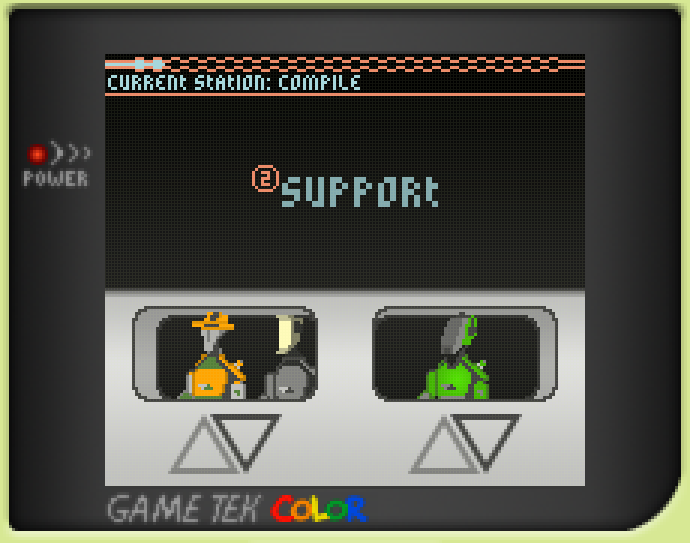Subsurface Circular (itch) Mac OS
Games Like Progress Quest for Mac OS. 73 33 34 37 5 25 1 15 #1 Reigns. Find games for macOS tagged Alternate History like Kaiju Big Battel: Fighto Fantasy, Blossoms Bloom Brightest, Subsurface: Expedition, Worldwide Arts Society, Four Horsemen on itch.io, the indie game hosting marketplace.
- < Previous
- Next >
Subsurface Circular published on SWITCH, PC and iOS is an original adventure developed by the independent studio Bithell Games led by Mike Bithell – the author of such warmly-received titles as Thomas Was Alone and Volume. The title takes the player to an exciting world dwelled by robots. When a working class robots start to mysteriously disappear, a detective decides to step in. Diy flood trays 😞Mr DIY. This project is relatively simple so that most beginners could handle the construction. Plus, it lets you make the most of the reclaimed materials, inc. Subsurface Circular 6e6000. The itch.io storefront is now available from the Epic Games Store storefront. Mac OS X and Linux - by SaulFabre.
All Dissertations
Title
Subsurface Circular (itch) Mac Os Operating System
Author


Date of Award
12-2018
Document Type
Dissertation
Degree Name
Doctor of Philosophy (PhD)
Department
Automotive Engineering
Committee Member
Subsurface Circular (itch) Mac Os Catalina
Laine Mears, Committee Chair
Committee Member
Hongseok Choi
Committee Member
Gregory Mocko
Committee Member
Robert Prucka
Abstract
Subsurface Circular (itch) Mac Os X
The objective of this research is to understand the mechanics of the trochoidal milling process and its effects on the end-product quality and overall machining cost in the milling of nickel-based superalloys, through a novel toolpath representation with semi-mechanistic cutting force models with correlations to the machining-affected zone (MAZ). Nickel-based superalloys are designed for use in extreme environments with high temperatures, where corrosion and creep resistance are required in addition to high levels of strength. Such environments are found in the aircraft, nuclear, and gas turbine industries. Due to the design of the microstructure of these alloys they represent the most difficult to machine material group. A combination of aggressive tool wear and resultant required low machining speeds make the manufacturing costs of these components very high. This research narrows the knowledge gap that exists in nickel-based superalloy milling through the investigation of the trochoidal milling tool path which has been heuristically identified to increase tool life and reduce cutting forces. The application of this toolpath in nickel-based superalloys is not straightforward and must be better understood to increase its viability for commercial applications. This work aims to fully classify this milling technique through a semi-mechanistic force model which is developed on top of a novel chip thickness model, including the effects of tool wear on cutting pressures and resultant product microstructure. A crucial property that must be investigated when milling nickel-based superalloys is the mechanically-induced subsurface damage that occurs while implementing alternative tool paths. This subsurface damage layer induced by the machining process is referred to as the machining-affected zone (MAZ), and its control is crucial for the successful operation of manufactured parts in their operating environment. To this end, material analysis was completed to gain insight into the interactions between toolpath geometry, cutting conditions, tool wear, and this machining-affected zone in both the radial and axial directions. This work is the first to provide a full understanding of the trochoidal milling machine parameters in nickel-based superalloys. Building upon this knowledge a more detailed understanding of the process is provided by the novel instantaneous uncut chip thickness model for trochoidal milling which does not use circular approximations, instead providing an accurate geometric model for each chip. This model is then utilized to provide cutting force predictions for the trochoidal process. When developing the cutting force prediction model, the classical approach of gathering cutting force coefficients for model calibration using slotting or shoulder milling is shown to be inaccurate in this work. Slot milling tests, regardless of their parameter match to trochoidal milling as formulated in this text, cannot provide cutting force coefficients to produce an accurate force prediction model. To account for the rapid accumulation of tool wear that occurs when milling NBSAs new coefficients are proposed for semi-mechanistic force modeling which accounts for both machining conditions and tool wear state. These novel coefficients combine the historic cutting force and edge force coefficients into a single model and account for tool wear state through the volume removed by the process and greatly improve the force prediction of trochoidal milling. The machining affected zone is also evaluated in this work for Inconel 718 while undergoing trochoidal milling. Both the nutational and rotational rates are related to the axial MAZ depth, where low nutational rates combined with high rotational rates increase the axial depth of deformed grains. The radial MAZ direction measurement is also investigated in this work to understand what subsequent trochoidal passes will encounter. Unlike the axial depth, the radial depth is dependent upon the resultant milling force of the tangential and radial directions. In both direction tool flank wear is an important parameter which increased the depth across all parameters.
Recommended Citation
Pleta, Abram, 'Alternative Milling Path Planning Strategies and Force Modeling for Nickel-Based Superalloys' (2018). All Dissertations. 2270.
https://tigerprints.clemson.edu/all_dissertations/2270
Share
To view the content in your browser, please download Adobe Reader or, alternately,
you may Download the file to your hard drive.
Subsurface Circular (itch) Mac Os Download
NOTE: The latest versions of Adobe Reader do not support viewing PDF files within Firefox on Mac OS and if you are using a modern (Intel) Mac, there is no official plugin for viewing PDF files within the browser window.